Aon Bundle
Who Really Controls Aon?
Ever wondered who's truly steering the ship at Aon, a global powerhouse in risk management and human capital solutions? Understanding Aon SWOT Analysis is just the beginning. The answer to "Who owns Aon company?" unlocks critical insights into its strategic direction, market performance, and long-term vision. Delve into the ownership structure of this industry leader and discover the forces shaping its future.
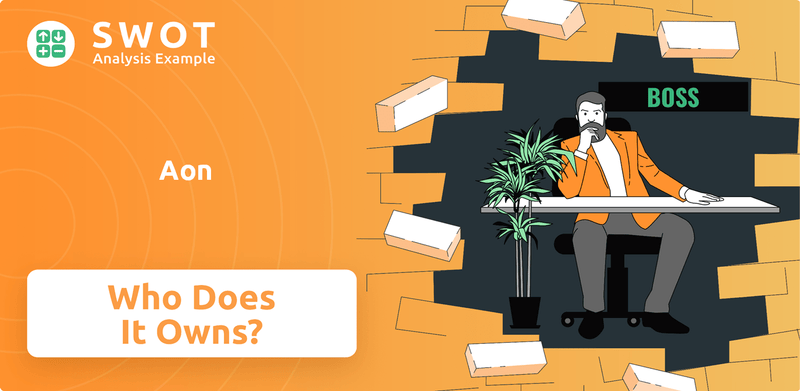
The Aon ownership structure, primarily comprised of institutional investors and public shareholders, is key to understanding the Aon Corporation's operations. Examining the evolution of Aon's shareholder base, including the influence of key institutional investors and the roles of Aon executives, offers a deeper comprehension of its governance. This analysis will explore the historical context of Aon, tracing its journey from its founding to its current status as a publicly traded company, shedding light on who owns Aon and the implications for its stakeholders.
Who Founded Aon?
The Aon company was established in 1982 through a strategic merger. This merger combined the interests of W. Clement Stone's Combined International Corporation and Patrick Ryan's Ryan Insurance Group. This foundational event set the stage for the company's future in the insurance and risk management sector.
W. Clement Stone, known for his influence in the insurance industry, founded Combined International Corporation in 1919. Patrick Ryan established Ryan Insurance Group in 1964. The merger brought together these two distinct entities, with Patrick Ryan becoming the CEO of the newly formed company.
The initial ownership of the Aon Corporation was primarily held by the shareholders of the merging entities. While the exact equity splits from the 1982 merger aren't publicly available in detail, the merger consolidated the business interests and leadership of Stone and Ryan. W. Clement Stone remained a key figure as Chairman Emeritus until his passing in 2002.
The company emerged from the merger of Combined International Corporation and Ryan Insurance Group.
W. Clement Stone and Patrick Ryan were the key figures behind the merger.
Patrick Ryan became the CEO, signaling a shift in leadership.
Early ownership was concentrated within the shareholders of the founding companies.
Ryan's vision largely guided the direction of the new company.
The integration of the two companies' interests was relatively smooth.
The initial Aon shareholders comprised the shareholders of the merging companies. The absence of major ownership disputes suggests a stable foundation. Understanding the early ownership dynamics is key to tracing the Aon company history.
- The merger consolidated the interests of the two founding entities.
- Patrick Ryan led the company as CEO, indicating his significant influence.
- W. Clement Stone remained involved as Chairman Emeritus.
- Early ownership was primarily held by the shareholders of the merging companies.
Aon SWOT Analysis
- Complete SWOT Breakdown
- Fully Customizable
- Editable in Excel & Word
- Professional Formatting
- Investor-Ready Format
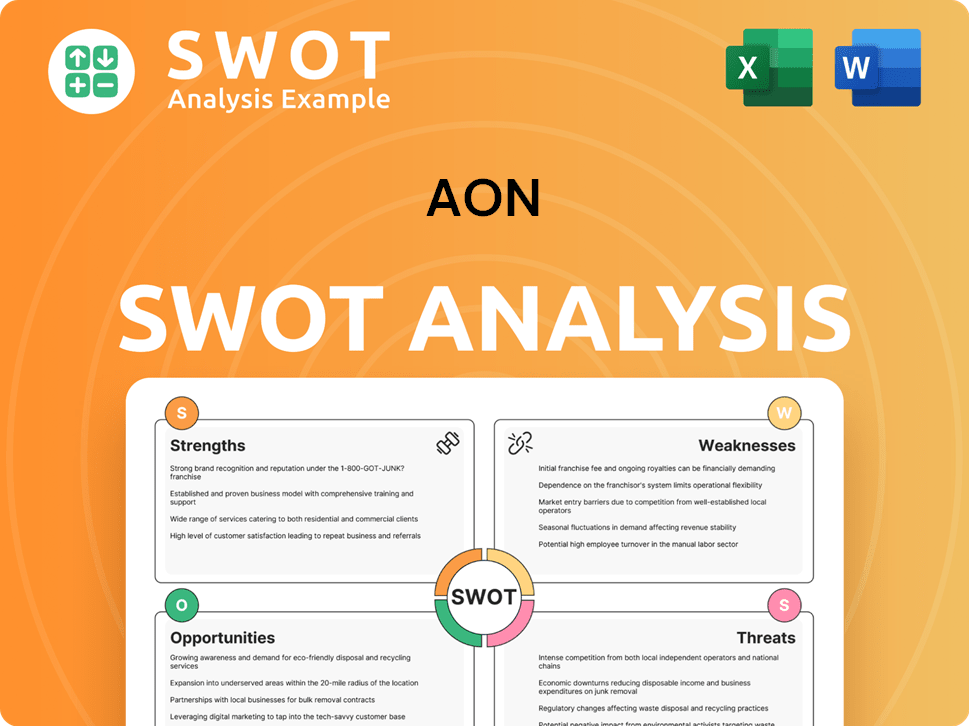
How Has Aon’s Ownership Changed Over Time?
The ownership structure of the Aon company has shifted considerably since its initial public offering. As a publicly traded entity listed on the New York Stock Exchange (NYSE: AON), Aon's ownership is primarily held by institutional investors. This is a common pattern for large-cap companies, where significant portions of shares are managed by investment firms on behalf of their clients. The evolution of Aon's ownership reflects its growth, strategic decisions, and the broader dynamics of the financial markets.
Key events have influenced Aon's ownership. The proposed acquisition of Willis Towers Watson in 2020, though it didn't go through, would have reshaped the ownership landscape. The company's organic growth and strategic acquisitions have naturally diluted the stakes of original founders. These changes highlight the company's journey from its origins to its current status as a major player in the insurance and financial services industry. Understanding the ownership structure provides insights into the company's governance, strategic direction, and the influence of major shareholders.
| Shareholder | Percentage of Shares (as of March 31, 2024) | Notes |
|---|---|---|
| Vanguard Group Inc. | 9.39% | One of the largest institutional investors. |
| BlackRock Inc. | 8.01% | Significant institutional shareholder. |
| State Street Corp. | 4.41% | Holds a substantial portion of Aon's shares. |
As of March 31, 2024, major institutional investors like Vanguard Group Inc., BlackRock Inc., and State Street Corp. collectively hold a significant portion of Aon's shares. Vanguard held approximately 9.39%, BlackRock held around 8.01%, and State Street held about 4.41%. Other significant shareholders include Capital Research Global Investors, Fidelity Management & Research Company LLC, and T. Rowe Price Associates Inc. This ownership distribution indicates a widely dispersed public ownership model, with no single entity holding a controlling interest. This structure often supports a more independent board and management, accountable to a broad shareholder base. The influence of these institutional investors shapes the company's strategic direction.
Aon's ownership is primarily held by institutional investors, reflecting a common trend among large-cap companies.
- Vanguard, BlackRock, and State Street are among the largest shareholders.
- The ownership structure has evolved due to acquisitions and market dynamics.
- Understanding Aon's ownership provides insights into its governance and strategic direction.
- The company is a publicly traded entity.
Aon PESTLE Analysis
- Covers All 6 PESTLE Categories
- No Research Needed – Save Hours of Work
- Built by Experts, Trusted by Consultants
- Instant Download, Ready to Use
- 100% Editable, Fully Customizable
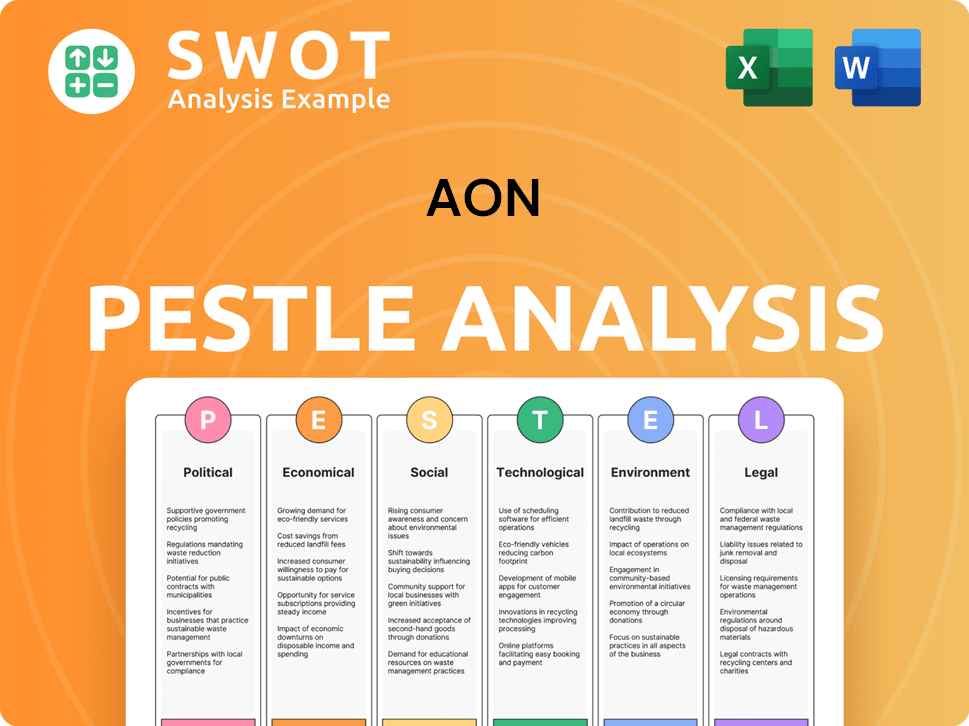
Who Sits on Aon’s Board?
The current Board of Directors of the Aon company includes a mix of independent directors and executive leadership, reflecting a commitment to corporate governance. As of early 2024, the board comprises individuals with diverse backgrounds in finance, technology, and global business. The board includes independent directors to ensure objective oversight. For example, the current executive chairman is Gregory C. Case, and the CEO is Eric Andersen. The board also includes independent directors such as Lester B. Knight, chair of the Compensation Committee, and Cheryl Gordon Krongard, chair of the Audit Committee. This structure is designed to provide robust oversight and strategic guidance.
The board's composition reflects a commitment to maintaining a balance between experience and independence. The presence of independent directors is crucial for ensuring that decisions are made in the best interests of all Aon shareholders. The board's structure aims to foster effective corporate governance and strategic oversight, which is essential for long-term value creation. The board's role includes overseeing the company's financial performance, strategic direction, and risk management, all of which are critical for maintaining stakeholder confidence and driving sustainable growth. The board's diverse expertise helps navigate the complexities of the global insurance and financial services landscape.
| Board Member | Position | Key Role |
|---|---|---|
| Gregory C. Case | Executive Chairman | Provides strategic oversight and guidance |
| Eric Andersen | CEO | Leads the company's operations and strategic initiatives |
| Lester B. Knight | Independent Director | Chairs the Compensation Committee |
| Cheryl Gordon Krongard | Independent Director | Chairs the Audit Committee |
The voting structure for Aon plc shares is generally one-share-one-vote. This structure ensures that voting power is directly proportional to the number of shares owned, preventing any single entity from having disproportionate control through special voting rights or dual-class shares. There are no publicly disclosed special voting rights, golden shares, or founder shares that would grant outsized control to specific individuals or entities. This structure is common among publicly traded companies and promotes fairness and transparency in corporate governance. For more insights, you can explore the Growth Strategy of Aon.
Aon's board is structured to ensure independent oversight and strategic guidance. The company maintains a one-share-one-vote system, promoting fair voting rights for all shareholders.
- The board includes a mix of independent directors and executive leadership.
- The voting structure is straightforward, with one vote per share.
- Governance practices are designed to align with shareholder interests.
- The focus is on strategic growth and shareholder value.
Aon Business Model Canvas
- Complete 9-Block Business Model Canvas
- Effortlessly Communicate Your Business Strategy
- Investor-Ready BMC Format
- 100% Editable and Customizable
- Clear and Structured Layout
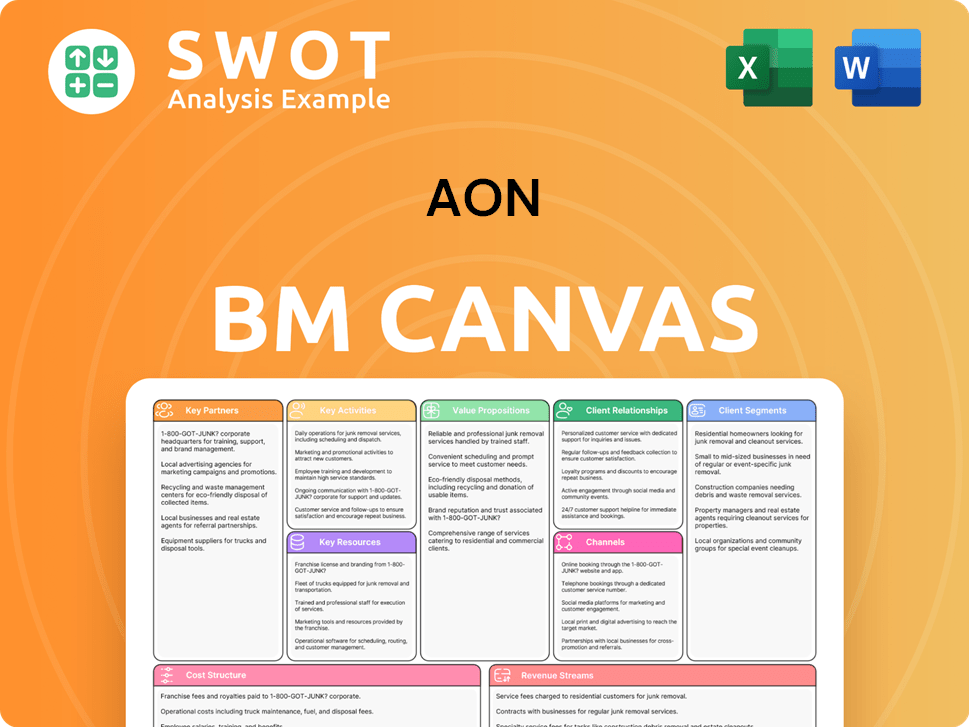
What Recent Changes Have Shaped Aon’s Ownership Landscape?
Over the past few years, the Aon company's ownership has reflected broader market trends. These include sustained institutional ownership and strategic capital allocation. The company's commitment to returning capital to shareholders is evident, with a new $5 billion share repurchase program announced in February 2024.
A significant event impacting Aon's strategic direction was the proposed merger with Willis Towers Watson. The merger, which was ultimately terminated in July 2021, would have altered the ownership landscape. The termination maintained Aon's pre-merger ownership structure, preventing a significant dilution of existing Aon shareholders. This strategic move ensured that the company's existing shareholders retained their stake, maintaining stability in the ownership profile.
| Aspect | Details | Impact |
|---|---|---|
| Share Repurchase Programs | Announced a new $5 billion share repurchase program in February 2024. | Increases ownership percentage for remaining shareholders. |
| Merger with Willis Towers Watson | Proposed merger terminated in July 2021. | Prevented substantial changes in ownership structure. |
| Institutional Ownership | Influenced by trends like increased institutional ownership and passive investing. | Suggests continued dispersion of ownership among institutional investors. |
Industry trends, such as increased institutional ownership, continue to influence the Aon Corporation. These trends suggest a continued dispersion of ownership among a vast number of institutional investors. Future ownership changes are likely to be incremental, driven by ongoing share repurchases and potential strategic acquisitions. To better understand the company's strategic positioning, you can explore the Target Market of Aon.
Aon has a history of share repurchases, indicating a focus on shareholder value. These repurchases can increase the ownership percentage of existing shareholders. The latest program, announced in February 2024, demonstrates continued commitment.
The terminated merger with Willis Towers Watson would have significantly altered the ownership landscape. The termination preserved the existing ownership structure. This decision maintained stability for current Aon shareholders.
Aon Porter's Five Forces Analysis
- Covers All 5 Competitive Forces in Detail
- Structured for Consultants, Students, and Founders
- 100% Editable in Microsoft Word & Excel
- Instant Digital Download – Use Immediately
- Compatible with Mac & PC – Fully Unlocked
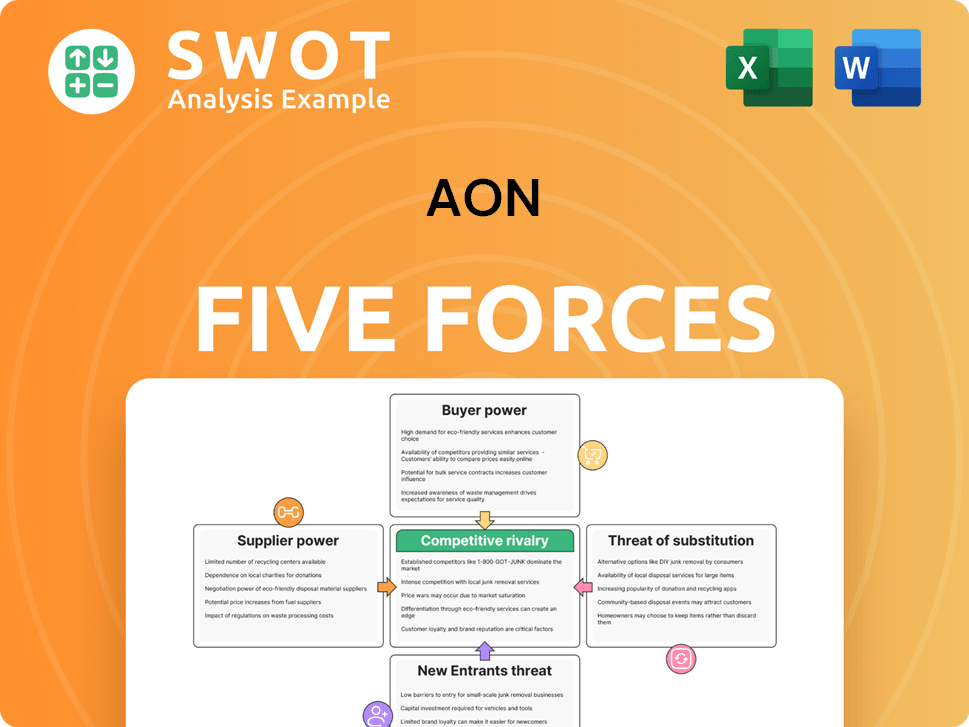
Related Blogs
- What are Mission Vision & Core Values of Aon Company?
- What is Competitive Landscape of Aon Company?
- What is Growth Strategy and Future Prospects of Aon Company?
- How Does Aon Company Work?
- What is Sales and Marketing Strategy of Aon Company?
- What is Brief History of Aon Company?
- What is Customer Demographics and Target Market of Aon Company?
Disclaimer
All information, articles, and product details provided on this website are for general informational and educational purposes only. We do not claim any ownership over, nor do we intend to infringe upon, any trademarks, copyrights, logos, brand names, or other intellectual property mentioned or depicted on this site. Such intellectual property remains the property of its respective owners, and any references here are made solely for identification or informational purposes, without implying any affiliation, endorsement, or partnership.
We make no representations or warranties, express or implied, regarding the accuracy, completeness, or suitability of any content or products presented. Nothing on this website should be construed as legal, tax, investment, financial, medical, or other professional advice. In addition, no part of this site—including articles or product references—constitutes a solicitation, recommendation, endorsement, advertisement, or offer to buy or sell any securities, franchises, or other financial instruments, particularly in jurisdictions where such activity would be unlawful.
All content is of a general nature and may not address the specific circumstances of any individual or entity. It is not a substitute for professional advice or services. Any actions you take based on the information provided here are strictly at your own risk. You accept full responsibility for any decisions or outcomes arising from your use of this website and agree to release us from any liability in connection with your use of, or reliance upon, the content or products found herein.